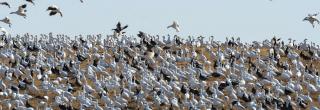
Amendment Number One to the 2024-2025 Small Game, Waterfowl and Furbearer Proclamation
Regulations Index
Proclamation Sections
- 4 - Hours of Hunting
- 5 - Traps, Firearms, Archery Equipment nad Ammunition
- 10 - Licenses or Special Permits
- 39 - Geese
- 43 - Electronic and Recorded Calls
Additional Regulations
Century and Administrative Code
General Information Links
NOTE: The following is a copy of the text from the 2025 Spring Light Goose Conservation Order. It includes regulations specific to spring goose.
A scanned copy of the signed proclamation is also available (pdf).
2025 Spring Light Goose Conservation Order
The following sections of the 2024-2025 Small Game, Waterfowl and Furbearer Proclamation dated July 19, 2024 are amended for the 2025 Spring Light Goose Conservation Order to read as follows.
4. HOURS OF HUNTING. Shooting hours for the 2025 Spring Light Goose Conservation Order shall be from one-half hour before sunrise to one-half hour after sunset each day.
5. TRAPS, FIREARMS, ARCHERY EQUIPMENT AND AMMUNITION.
Light Geese: Shotguns capable of holding in excess of 3 shells may be used to take light geese during the 2025 Spring Light Goose Conservation Order.
10. LICENSES OR SPECIAL PERMITS.
Resident hunters must possess a valid current hunting certificate, a small game license for ages 16 and older, a general game and habitat license, or a combination license. 2024-2025 licenses expire on March 31, 2025.
Non-resident hunters only need a 2025 non-resident spring light goose license.
A Federal Duck Stamp is not required.
All migratory game bird hunters must be certified through the Harvest Information Program (HIP) issued by ND for 2025.
39. GEESE. Light geese include snow geese (white and blue phase) and Ross’s geese. Light geese may be taken statewide from February 15, 2025 - May 11, 2025. There shall be no daily or possession limit on light geese.
43. ELECTRONIC AND RECORDED CALLS. Electronic and recorded calls may be used to take light geese during the 2025 Spring Light Goose Conservation Order.
Signed by Governor Kelly Armstrong on January 17, 2025.
Attest by Secretary of State
Additional Regulations and Information
Additional Regulations
- Waterfowl rest areas designated for 2024 are not in effect during this conservation order; however, private lands within a rest area may be posted.
- Nontoxic shot is required for hunting light geese.
- Driving off established roads and trails is strongly discouraged during this hunt because of the likelihood of soft, muddy field conditions, and winter wheat that is planted across the state. To encourage positive landowner/hunter relations, please seek permission before attempting any off-road travel. Sprouted winter wheat is considered an unharvested crop, therefore hunting or off-road travel in winter wheat is not legal without landowner permission.
- Wanton waste of migratory game birds. No person shall hunt any migratory game bird without making a reasonable effort to retrieve downed birds, and retain them in his/her possession until processing.
